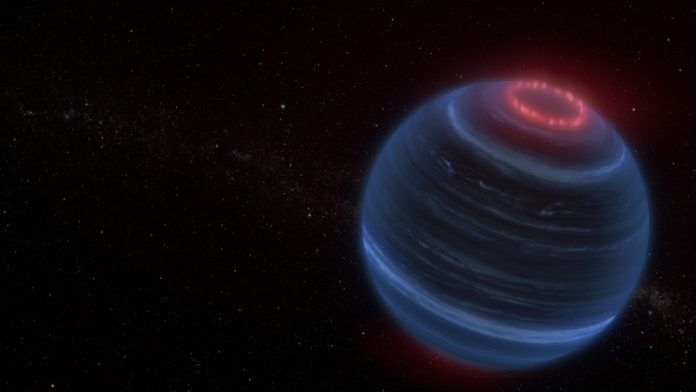
Have you ever heard of brown dwarfs?
They’re these fascinating space objects, bigger than planets like Jupiter but not quite big enough to be stars.
Well, the James Webb Space Telescope has just found something amazing about one of these brown dwarfs, and it’s got astronomers scratching their heads in wonder.
This particular brown dwarf, called W1935, is grabbing attention because of something unusual happening in its atmosphere.
It’s emitting light in a way scientists didn’t expect, especially because it’s really cold and floating in space all by itself, without a star nearby. This light is coming from methane – a type of gas – and the big question is: what’s making it glow?
When scientists study planets like Jupiter and Saturn in our solar system, they see this kind of glowing methane too. It happens because of aurorae, those beautiful light displays that we sometimes see on Earth near the poles.
Aurorae happen when particles from the sun hit a planet’s magnetic field and then light up the atmosphere. Jupiter and Saturn have aurorae, and they get even more interesting with a little help from their nearby moons.
But here’s the twist: W1935 doesn’t have a sun or moons around it. So, what’s causing the aurorae-like effect? It’s like a space detective story!
The story began with a team led by Jackie Faherty, an astronomer at the American Museum of Natural History. They were using the Webb telescope to look at 12 cold brown dwarfs, including W1935, discovered by a citizen scientist, Dan Caselden.
They found that W1935 and another brown dwarf, W2220, were almost like twins in many ways – same brightness, temperature, and mostly similar chemicals. But W1935 stood out because of its glowing methane.
Typically, methane absorbs light, but in W1935’s case, it was emitting light. That was a big surprise! “What the heck? Why is methane emission coming out of this object?” was Faherty’s first reaction.
To figure out why, they used computer models and compared what they saw with what we know about planets in our solar system. They found that W1935 has a weird temperature pattern. Instead of getting colder as you go higher in its atmosphere, it gets warmer. This kind of temperature inversion is really strange, especially without a nearby star to heat it up.
Aurorae could be the key to this mystery. In our solar system, they can heat up the atmospheres of planets like Jupiter and Saturn. The same might be happening on W1935, but without the help of a star or moons. This is a first-of-its-kind discovery!
Previously, astronomers thought aurorae on brown dwarfs were a thing because they detected radio waves, which are another sign of aurorae. But W1935 is unique – it’s the first time they’ve seen methane emission linked to aurorae outside our solar system. And it’s much colder than the other brown dwarfs where they suspected aurorae.
So, what’s going on with W1935? Is it an internal process, or something external like interstellar plasma?
The mystery continues, but one thing’s for sure – with the Webb telescope, we’re unlocking secrets of the universe in ways we never imagined before. It’s like opening the hood on a car and exploring what’s inside, but for space!



